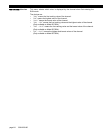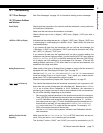
page 70 008-0608-00
Figure 10-2: Shunt Calibration Resistor Location
To verify proper transducer operation, you can apply the shunt resistor to the trans-
ducer while the instrument is in the RUN mode. Press and hold the [ENTER] button
for three seconds; this will apply the shunt resistor and display the reading.
KNOWN POINT x/y
Menu Items
This enters the engineering units for the known-load calibration points. These points
must match the actual loads that you will apply to the instrument during calibration.
The number of calibrations points depends on the
CALIBRATION TYPE
.
When using the 2-Point Known Load Calibration type, the following menu items are
available:
•“
KNOWN POINT 1/2
”: point 1 of 2, usually 0% of the transducer’s full-scale capacity.
•“
KNOWN POINT 2/2”
: point 2 of 2, usually 100% of the transducer’s full-scale capacity.
When using the 3-Point Known Load Calibration type, the following menu items are
available:
•“
KNOWN POINT 1/3
”: point 1 of 3, usually 0% of the transducer’s full-scale capacity.
•“
KNOWN POINT 2/3
”: point 2 of 3, usually 50% of the transducer’s full-scale capacity.
•“
KNOWN POINT 3/3
”: point 3 of 3, usually 100% of the transducer’s full-scale capacity.
When using the 5-Point Known Load Calibration type, the following menu items are
available:
•“
KNOWN POINT 1/5
”: point 1 of 5, usually 0% of the transducer’s full-scale capacity.
•“
KNOWN POINT 2/5
”: point 2 of 5, usually 25% of the transducer’s full-scale capacity.
•“
KNOWN POINT 3/5
”: point 3 of 5, usually 50% of the transducer’s full-scale capacity.
•“
KNOWN POINT 4/5
”: point 4 of 5, usually 75% of the transducer’s full-scale capacity.
•“
KNOWN POINT 5/5
”: point 5 of 5, usually 100% of the transducer’s full-scale capacity.
These menu items are only available with the Known-Load Calibration types.
NOTICE
To insure both correct operation of the transducer and application of the load,
the instrument expects the voltage applied at each known-load point to be
increasing. For example, the load applied at Known-Load Point 2/2 must
cause the transducer to produce a more positive voltage than at Known-Load
Point 1/2.


















